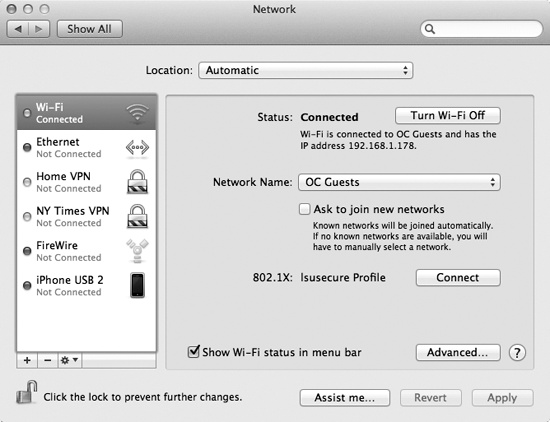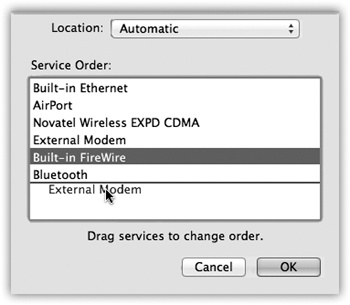 Network Central and Multihoming
by David Pogue
Switching to the Mac: The Missing Manual, Mountain Lion Edition
Network Central and Multihoming
by David Pogue
Switching to the Mac: The Missing Manual, Mountain Lion Edition
- Switching to the Mac: The Missing Manual, Mountain Lion Edition
- A Note Regarding Supplemental Files
- The Missing Credits
- Introduction
- One. Welcome to Macintosh
- 1. How the Mac Is Different
- 2. Folders, Dock & Windows
- 3. Files, Icons & Spotlight
- 4. Documents, Programs & Mission Control
- A Word About Apps
- The Mac App Store
- Other Ways to Get Mac Software
- Opening OS X Programs
- Launchpad
- Windows that Auto-Reopen
- The Application Menu
- The “Heads-Up” Program Switcher
- Mission Control: Death to Window Clutter
- Dashboard
- Exposé
- Hiding Programs the Old-Fashioned Way
- How Documents Know Their Parents
- Keyboard Control
- The Save and Open Dialog Boxes
- Auto Save and Versions
- Documents in the Cloud
- 5. Entering, Moving & Backing up Data
- Two. Making the Move
- 6. Transferring Your Files to the Mac
- 7. Special Software, Special Problems
- ACDSee
- Acrobat Reader
- ACT
- Ad Subtract (Pop-Up Stopper)
- Adobe [your favorite program here]
- AOL
- AIM (AOL Instant Messenger)
- Children’s Software
- Chrome
- Easy CD Creator
- Encarta
- Eudora
- Excel
- Firefox
- Games
- Google Desktop Search
- Google Earth
- Google Chrome
- ICQ
- Internet Explorer
- iTunes
- McAfee VirusScan
- Microsoft Access
- Microsoft Money
- Microsoft Office
- Microsoft Publisher
- Microsoft Visio
- Minesweeper
- MSN Messenger
- NaturallySpeaking
- Netscape
- Newsgroup Readers
- Norton AntiVirus
- Norton Utilities
- Notepad
- Outlook/Outlook Express/Windows Mail
- Paint Shop Pro
- Palm Desktop
- Picasa
- PowerPoint
- QuickBooks
- Quicken
- RealPlayer
- RssReader
- Skype
- SnagIt (Screenshots)
- Solitaire
- Street Atlas USA
- TaxCut, TurboTax
- WinAmp, MusicMatch
- Windows Media Player
- WinZip
- Word
- WordPerfect
- Yahoo Messenger
- 8. Windows on Macintosh
- 9. Hardware on the Mac
- Mac Meets Printer
- Making the Printout
- Managing Printouts
- Printer Sharing
- Faxing
- PDF Files
- Fonts—and Font Book
- Digital Cameras
- Disks
- Startup Disks
- Erasing a Disk
- Burning CDs and DVDs
- iTunes: The Digital Jukebox
- DVD Movies
- AirPlay
- Keyboards
- Mouse
- Monitors
- Scanners
- Three. Making Connections
- 10. Internet Setup & iCloud
- 11. Mail & Contacts
- Checking Your Mail
- Writing Messages
- Stationery
- Reading Email
- VIPs
- The Anti-Spam Toolkit
- Contacts
- 12. Safari & Messages
- Four. Putting Down Roots
- 13. Accounts, Parental Controls & Security
- 14. Networking, File Sharing & Screen Sharing
- 15. System Preferences
- The System Preferences Window
- Accessibility
- Bluetooth
- CDs & DVDs
- Date & Time
- Desktop & Screen Saver
- Dictation & Speech
- Displays
- Dock
- Energy Saver
- General
- iCloud
- Keyboard
- Language & Text
- Mail, Contacts & Calendars
- Mission Control
- Mouse
- Network
- Notifications
- Parental Controls
- Print & Scan
- Security & Privacy
- Sharing
- Software Update
- Sound
- Spotlight
- Startup Disk
- Time Machine
- Trackpad
- Users & Groups
- 16. The Freebie Programs
- Your Free OS X Programs
- App Store
- Automator
- Calculator
- Calendar
- Chess
- Contacts
- Dashboard
- Dictionary
- DVD Player
- FaceTime
- Font Book
- Game Center
- GarageBand
- Image Capture
- iMovie, iPhoto
- iTunes
- Launchpad
- Messages
- Mission Control
- Notes
- Notification Center
- Photo Booth
- Preview
- QuickTime Player
- Reminders
- Safari
- Stickies
- System Preferences
- TextEdit
- Time Machine
- Utilities: Your OS X Toolbox
- Activity Monitor
- AirPort Utility
- AppleScript Editor
- Audio MIDI Setup
- Bluetooth File Exchange
- Boot Camp Assistant
- ColorSync Utility
- Console
- DigitalColor Meter
- Disk Utility
- Grab
- Grapher
- Java Preferences
- Keychain Access
- Migration Assistant
- Network Utility
- RAID Utility
- System Information
- Terminal
- VoiceOver Utility
- Five. Appendixes
- A. Installing OS X Mountain Lion
- B. Troubleshooting
- C. The Windows-to-Mac Dictionary
- About [this program]
- About [this program]
- Accessibility Options control panel
- Active Desktop
- Add Hardware control panel
- Add or Remove Programs control panel
- All Programs
- Alt key
- Automatic Update
- Backspace key
- Battery level
- BIOS
- Briefcase
- Calculator
- Camera and Scanner Wizard
- CDs and DVDs
- Character Map
- Clean Install
- Clipboard
- Command line
- Control Panel
- Copy, Cut, Paste
- Ctrl key
- Date and Time
- Delete Key (Forward Delete)
- Desktop
- Directories
- Disk Defragmenter
- Disks
- Display control panel
- DLL files
- DOS prompt
- Drivers
- End Task dialog box
- Exiting programs
- Explorer
- Favorites
- Faxing
- File Sharing
- Floppy disks
- Folder Options
- Fonts
- Help and Support
- Hibernation
- Internet Explorer
- Internet Options
- IRQs
- Java
- Keyboard control panel
- Logging in
- Mail control panel
- Maximize button
- Menus
- Minimize button
- Mouse control panel
- (My) Computer
- (My) Documents, (My) Pictures, (My) Music
- (My) Network Places
- Network Neighborhood
- Notepad
- Phone and Modem Options control panel
- Power Options
- Printer Sharing
- Printers and Faxes
- PrntScrn key
- Program Files folder
- Properties dialog box
- Recycle Bin
- Regional and Language Options control panel
- Registry
- Run command
- Safe Mode
- ScanDisk
- Scheduled Tasks
- Scrap files
- Screen saver
- Search
- Shortcut menus
- Shortcuts
- Sounds and Audio Devices
- Speech control panel
- Standby mode
- Start menu
- StartUp folder
- System control panel
- System Tray
- Taskbar
- Taskbar and Start Menu control panel
- “Three-fingered salute”
- ToolTips
- Tweak UI
- User Accounts control panel
- Windows (or WINNT) folder
- Windows logo key
- Windows Media Player
- Windows Messenger
- WordPad
- Zip files
- About [this program]
- D. The Master OS X Secret Keystroke List
- Index
- About the Author
- Colophon
- Copyright
In this chapter, you’ll be spending a lot of time in the Network
pane of System Preferences (Figure 10-1). (Choose
![]() →System Preferences; click Network.) This list
summarizes the ways your Mac can connect to the Internet or an office
network—Ethernet, WiFi, Bluetooth, cellular modem card, VPN, and so
on.
→System Preferences; click Network.) This list
summarizes the ways your Mac can connect to the Internet or an office
network—Ethernet, WiFi, Bluetooth, cellular modem card, VPN, and so
on.
The order of the network connections listed in the Network pane is important. That’s the sequence the Mac uses as it tries to get online. If one of your programs needs Internet access and the first method isn’t hooked up, then the Mac switches to the next available connection automatically.
Figure 10-1. You set up all your network connections here, and you can connect to and disconnect from all your networks here. The listed network connections are tagged with color-coded dots. A green dot means turned on and connected to a network; yellow means the connection is working but some other setting is wrong (for example, your Mac can’t get an IP address); red means there’s no connection, or you haven’t yet set up a connection.
In fact, OS X can maintain multiple simultaneous network connections—Ethernet, WiFi, dial-up, even FireWire—with a feature known as multihoming.
This feature is especially relevant for laptops. When you open your Web browser, your laptop might first check to see if it’s plugged into an Ethernet cable, which is the fastest, most secure type of connection. If there’s no Ethernet, then it looks for a WiFi network.
Here’s how to go about setting up the connection-attempt sequence you want:
Open System Preferences. Click the Network icon.
The Network Status screen (Figure 10-1) brings home the point of multihoming: You can have more than one network connection operating at once.
From the
 pop-up menu, choose
Set Service Order.
pop-up menu, choose
Set Service Order.Now you see the display shown in Figure 10-2. It lists all the ways your Mac knows how to get online, or onto an office network.
Drag the items up and down the list into priority order.
If you have a wired broadband connection, for example, you might want to drag Built-in Ethernet to the top of the list, since that’s almost always the fastest way to get online.
Click OK.
You return to the Network pane of System Preferences, where the master list of connections magically re-sorts itself to match your efforts.
Your Mac will now be able to switch connections even in real time, during a single Internet session. If lightning takes out your Ethernet hub in the middle of your Web surfing, your Mac will seamlessly switch to your WiFi network, for example, to keep your session alive.
All right, then: Your paperwork is complete. The following pages guide you through the process of setting up these various connections.
-
No Comment

